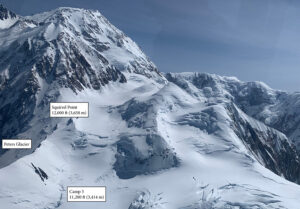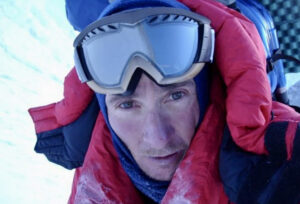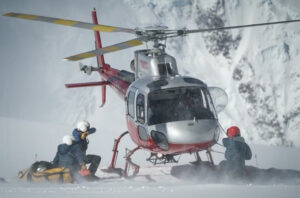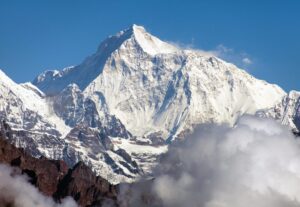Jost Kobusch is about to begin his attempt to solo Denali in winter. He hopes that Alaska’s extreme conditions will prepare him for his long-term goal of climbing winter Everest. The German climber spoke to ExplorersWeb yesterday before driving from Anchorage to Talkeetna.
“I’ll climb the West Buttress until the camp at 14,200 feet [4,330m], then proceed up the Messner Couloir,” Kobusch said. “I’ll climb in a single push, but it will definitely not be fast.”
He expects extremely windy conditions. Kobusch will ski and drag a sled until the camp before the Messner Couloir but he is not intending to ski down the mountain.
“I’ll use skis as a means of transportation and to reduce the risk of falling into a crevasse,” he said. “Actually, I am wearing 8,000m boots, too soft to ski in.”

From Talkeetna, Jost Kobusch will fly by bush plane to his Base Camp at Denali. Photo: Jost Kobusch/Instagram stories
Kobusch planned to climb Denali in January 2019, but his expedition failed back in Talkeetna because one of the U.S. government shutdowns closed Denali National Park. (Note: most of the photos illustrating this story were shot back then).
The challenges ahead
As one of the Seven Summits, Denali is a popular destination for climbers. Its normal route involves few technical sections. But the mountain’s remoteness and harsh weather make it a serious endeavor at any time of year.
Only 17 climbers have summited Denali in winter, and six have died trying. Vern Tejas was the first solo Denali in winter, back in March 1988. In 2015, Lonnie Dupre soloed the mountain in January, on his fourth attempt. Japanese adventurer Naomi Uemura also reached the top alone in February 1984, but he perished on the way down.
Says Kobusch: “Temperatures may easily reach -40ºC in Base Camp, which is located below 2,000m. I will only use that Base Camp at the beginning and at the end of the expedition. Before I set off up the mountain, I’ll bury 12 days of supplies there. That is how long it could take for a plane to airlift me out after the climb [because of bad weather].”

Jost Kobusch’s Base Camp will look very much like this one, shot during preparations for a previous attempt in 2019. Photo: Fabian Janssen
He points out that Base Camp is quite far from Denali itself, and he has to make a long glacier traverse to reach the foot of the mountain.
“In the arctic winter, it’s going to be dark most of the time,” he points out. “The jet stream winds will make conditions really hard. Crevasses are also a problem when traveling solo on glaciers. It is really remote and I’ll be completely on my own, [making] slow, cautious progress.”
Kobusch will have to anchor his tent well against the wind, and will also build some snow caves. Denali climbers often construct snow walls to shelter their tents from the wind. It’s a tough, strenuous job, especially for a soloist.

Photo: Jost Kobusch/Instagram stories
The main difference between Denali and Everest is the polar winter, which is dark and even colder than the high Himalaya. To avoid moisture accumulation, he plans to use artificial insulation rather than down, which means a gigantic bag. Kobusch will also use a plastic liner as a vapor barrier, so he will be slightly soggy in his sleeping bag.
Hard to train for winter in this year’s Alps
Recently, Kobusch had a long, slow recovery from the dengue fever he contracted in Nepal last fall. It took him two months to leave the symptoms behind. The exceptionally dry and warm conditions in the Alps through December and the first half of January didn’t allow him to train for the cold and biting winds he’ll face on the roof of North America.
“Yeah, it’s been kind of a summer training,” Kobusch said. “I traveled to southern France and climbed snow-free mountains there, but it was the best option. After all, I know how winter feels, so I am not concerned about the cold.”
Ready to suffer

Long hours in darkness will test Kobusch’s mental strength. Photo: Jost Kobusch 2019 archive/Feline Gerhardt
“I feel I am sufficiently prepared…yet I know it is going to be hard. The biggest challenge will be the mental one. It is going to be all about suffering. But it is a purifying pain, so I am looking forward to it.”
At 6,190m, Denali is 2,660m lower than Everest. On his first exploratory climb of winter Everest in 2020, Kobusch reached nearly 7,500m. So altitude should not be a problem for him, even though Denali’s northern latitude means lower air pressure compared to the Himalaya. Denali in winter is about equal to a 7,000m peak, Kobusch estimates.

A bush plane is the only way in and out of the Kahiltna Glacier, which accesses Denali’s West Buttress route. Photo: Fabian Janssen
Altitude aside, winter Denali is colder, darker, and, most of all, much more isolated. “In the end, I’d say the challenges ahead are different, but overall this expedition will be really good for the Everest project,” he says.
Kobusch will carry a tracker with him during the climb. You can follow him here.






